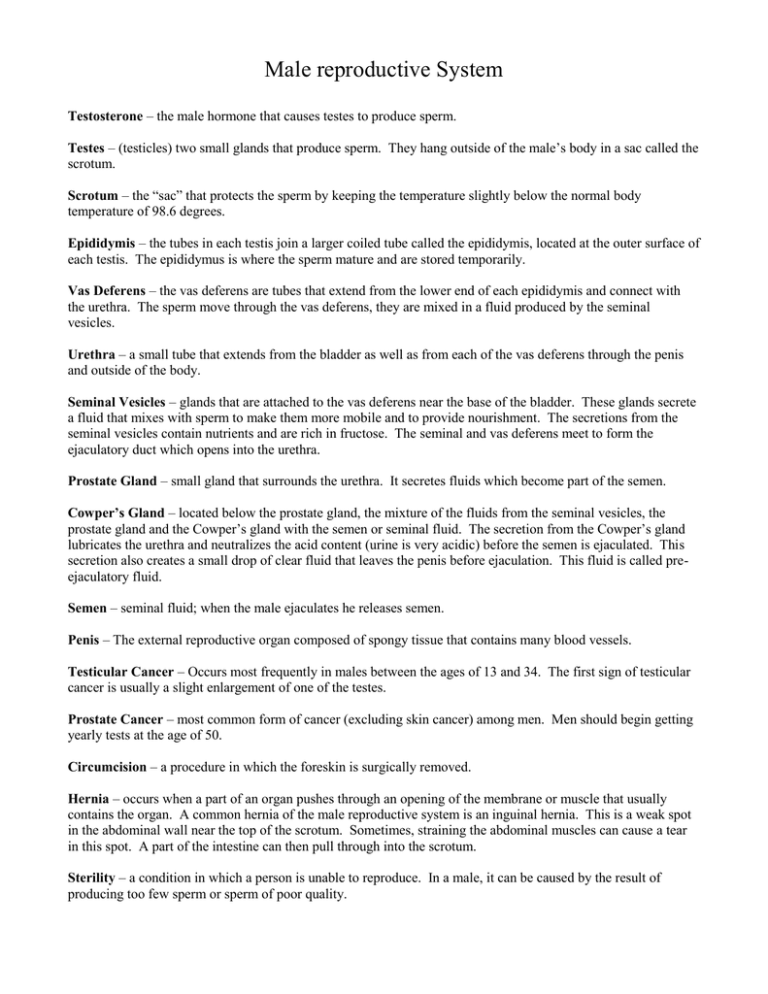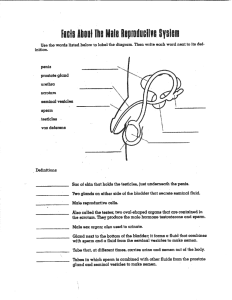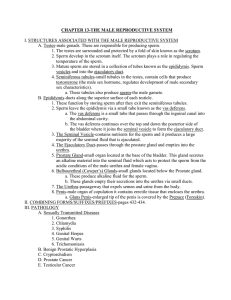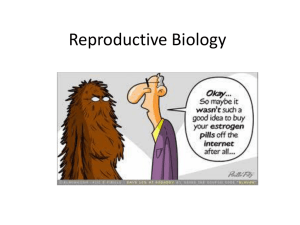Male reproductive System
advertisement

Male reproductive System Testosterone – the male hormone that causes testes to produce sperm. Testes – (testicles) two small glands that produce sperm. They hang outside of the male’s body in a sac called the scrotum. Scrotum – the “sac” that protects the sperm by keeping the temperature slightly below the normal body temperature of 98.6 degrees. Epididymis – the tubes in each testis join a larger coiled tube called the epididymis, located at the outer surface of each testis. The epididymus is where the sperm mature and are stored temporarily. Vas Deferens – the vas deferens are tubes that extend from the lower end of each epididymis and connect with the urethra. The sperm move through the vas deferens, they are mixed in a fluid produced by the seminal vesicles. Urethra – a small tube that extends from the bladder as well as from each of the vas deferens through the penis and outside of the body. Seminal Vesicles – glands that are attached to the vas deferens near the base of the bladder. These glands secrete a fluid that mixes with sperm to make them more mobile and to provide nourishment. The secretions from the seminal vesicles contain nutrients and are rich in fructose. The seminal and vas deferens meet to form the ejaculatory duct which opens into the urethra. Prostate Gland – small gland that surrounds the urethra. It secretes fluids which become part of the semen. Cowper’s Gland – located below the prostate gland, the mixture of the fluids from the seminal vesicles, the prostate gland and the Cowper’s gland with the semen or seminal fluid. The secretion from the Cowper’s gland lubricates the urethra and neutralizes the acid content (urine is very acidic) before the semen is ejaculated. This secretion also creates a small drop of clear fluid that leaves the penis before ejaculation. This fluid is called preejaculatory fluid. Semen – seminal fluid; when the male ejaculates he releases semen. Penis – The external reproductive organ composed of spongy tissue that contains many blood vessels. Testicular Cancer – Occurs most frequently in males between the ages of 13 and 34. The first sign of testicular cancer is usually a slight enlargement of one of the testes. Prostate Cancer – most common form of cancer (excluding skin cancer) among men. Men should begin getting yearly tests at the age of 50. Circumcision – a procedure in which the foreskin is surgically removed. Hernia – occurs when a part of an organ pushes through an opening of the membrane or muscle that usually contains the organ. A common hernia of the male reproductive system is an inguinal hernia. This is a weak spot in the abdominal wall near the top of the scrotum. Sometimes, straining the abdominal muscles can cause a tear in this spot. A part of the intestine can then pull through into the scrotum. Sterility – a condition in which a person is unable to reproduce. In a male, it can be caused by the result of producing too few sperm or sperm of poor quality.







